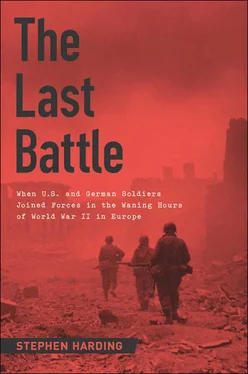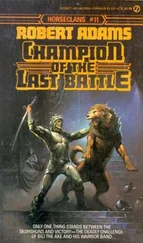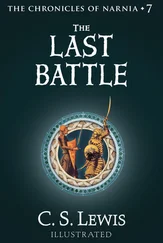37. Organizational and equipment details drawn from Die Nebel-und Werfertruppe (Regimentsbögen) , vol. 1, 322, as listed on the excellent German research site Lexikon der Wehrmacht.
38. The award—an eight-pointed star with a swastika in the center—was given in recognition of the recipient’s bravery and outstanding achievement in combat. Awardees had to have already received both the Iron Cross Second Class and First Class.
39. Paape had taken command of the brigade in late March. He wrote a fascinating postwar account of the unit’s final days, 7th Werfer Brigade, 24 March–30 April 1945 , as part of the U.S. Army’s Foreign Military Studies series.
40. On March 10, 1945, Hitler had issued a “Führer Order” directing the creation of mobile courts-martial units whose task was to find and punish any member of the Wehrmacht or SS, regardless of rank, who was neglecting his duty. Negotiating with Allied forces or collaborating with local resistance organizations was grounds for immediate execution.
41. Named after Fritz Todt, the engineer and high-ranking Nazi who founded it, the Organization Todt (OT) was the Third Reich’s primary civil-and military-construction agency. In the prewar years OT constructed Germany’s autobahns and frontier fortifications, and after September 1939 it expanded into military construction throughout the Reich and the occupied territories. The organization used “compulsory” workers almost exclusively; initially these were German citizens unfit for military service, but, as the war progressed, the workforce was predominantly made up of slave laborers: prisoners of war, political prisoners, and concentration-camp inmates.
42. Details on the meeting are drawn from Resistance and Persecution in Austria, 1938–1945 , 594–595.
43. Though Battle Group Forster was in reserve at Wörgl, the actual defense of the city and its environs had been made part of Giehl’s responsibility.
44. According to von Hengl’s postwar account, the initial American attack was followed by an intense artillery barrage aimed at the next town to the south, Oberaudorf, which was packed with refugees and from which all German military units had already withdrawn. Von Hengl called a brief truce, crossed the front lines under a white flag, and convinced the Americans not to shell any town in which German forces were not actually visible. His mission accomplished, the general crossed the front lines once again and resumed the fight.
45. The full text of the message, translated in Headquarters, 103d Infantry Division, Operations in Germany, Austria and Italy, May 1945 , 4, read: “At the present juncture of the war, everything depends on a stubborn and inflexible determination to hold on at all costs. The display of white flags, the removal of an antitank barrier, desertion from the Volksturm or similar manifestations are offenses which must be ruthlessly punished. All male persons inhabiting a house showing a white flag will be shot. No hesitation in executing these orders can be permitted any longer. ‘Male persons’ who are to be considered responsible in this respect are those aged 14 years or over.”
1. Prison Journal , 292.
2. Ibid., 294.
3. Ibid., 296.
4. Ibid., 283.
5. A fiery, 80-proof German brandy.
6. For example, in the summer of 1944 Čučković was able to repair a small electric motor that Wimmer intended to use in the farmhouse he and his wife were renovating (possibly as a postwar hideout) about 1.5 miles northeast of Schloss Itter. The SS-TV officer gave the Croat 30 Reichsmarks and allowed him to spend time with his wife, Ema, and son, Zvonimir, who had traveled down from the outskirts of Munich and were staying with a family in Itter village. For five nights Čučković was allowed to leave the castle by himself after dark but had to be back in each morning by six. See Čučković, “Zwei Jahren auf Schloss Itter,” 40.
7. All three incidents are described in Čučković, “Zwei Jahren auf Schloss Itter,” 39–41.
8. Daladier, Prison Journal , 317–318.
9. Reynaud, In the Thick of the Fight , 653.
10. Even after the war the area around Schloss Itter continued to be a way station for former Nazis seeking to escape Allied justice. Among the most infamous was Adolf Eichmann, one of the primary organizers of the Holocaust. As part of his escape to Argentina in 1950, the former SS-TV officer crossed into Austria at Kufstein and, with the help of local sympathizers, made his way to Innsbruck. From there he crossed into Italy and then traveled on to South America. Abducted by Israeli agents in 1960, he was taken to Israel, tried for war crimes and crimes against humanity, and executed in 1962.
11. Daladier, Prison Journal , 336. Among those accompanying Weiter was his adjutant, whom Daladier described as “tall and fat, a real thug.”
12. Reynaud’s postwar account says May 1, but Weiter killed himself sometime between one AM and six AM on May 2. Nor was Weiter the only senior SS man to commit suicide in the vicinity of Schloss Itter. Just days after the Dachau commandant killed himself, SS-Major Hermann Müller-John, commander and bandmaster of the ninety-six-man orchestra of the Leibstandarte Adolf Hitler—the führer’s bodyguard regiment—killed his wife, his nineteen-year-old daughter, and himself in a farmhouse within a few miles of Itter. He apparently wished to avoid postwar prosecution for his involvement—and that of the band members he led—in the murder of some fifty Jews on the night of Sept. 18–19, 1939, in Blonie, Poland.
13. Reynaud, In the Thick of the Fight , 653.
14. Ibid.
15. Ibid.
16. The bulk of the information used in this volume concerning Schrader’s early life and wartime career is drawn from his ultimately unpublished postwar memoir, “Erinnerungen, Gedanken, Erkenntnisse” (“Memories, Thoughts, Insights”), and from Schrader’s entry in John P. Moore’s excellent Signal Officers of the Waffen-SS .
17. Schrader, “Erinnerungen, Gedanken, Erkenntnisse,” 5.
18. Known in German as the Reichsarbeitdienst, or R.A.D., the organization had been created in 1931 as the Freiwilliger Arbeitsdienst (Voluntary Labor Service) as a way to provide work for Germany’s many unemployed people. Structured along military lines, it undertook civic construction projects. Following the Nazis’ assumption of power, service in the renamed R.A.D. was made compulsory for all German males between eighteen and twenty-five. Upon completion of that service young men entered the military for two years.
19. Schrader’s SS-number was 353 103.
20. Schrader, “Erinnerungen, Gedanken, Erkenntnisse,” 16.
21. Ibid., 20.
Читать дальше












